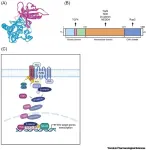(Press-News.org) A new paper in Trends in Pharmacological Sciences from researchers at generative artificial intelligence (AI)- and robotics-powered clinical stage drug discovery company Insilico Medicine (“Insilico”) and ETH Zurich reveals the broad potential of TNIK as a therapeutic target for some of the most pervasive aging-related diseases, including fibrosis, cancer, obesity, and Alzheimer’s. The findings could guide the development of new therapeutics. The lead drug in Insilico’s pipeline, INS018_055, is an AI-designed TNIK inhibitor being advanced as a treatment for the deadly lung disease idiopathic pulmonary fibrosis (IPF) and is currently in Phase II trials with patients.
TNIK, a member of the germinal center kinase (GCK) family, has been found to play a significant role in biological processes relevant to disease states, including cell migration, cytoskeletal organization, and cell proliferation in malignant and healthy cells.
TNIK is a reasonably novel but trending therapeutic target with around 150 papers referencing it on PubMed – most of them published since 2020. Few papers refer to it as a therapeutic target.
In cancer, TNIK has been found to drive cancer cell proliferation, treatment resistance, and cell migration across multiple cancer types – including colorectal, ovarian, thyroid, osteosarcoma, and lung squamous cell carcinoma (LSCC) – due to its activation of the Wnt signaling pathway. Aberrant Wnt signaling enhances T-cell factor 4 (TCF4) transcription factor activity and transcription of TCF4 target genes, promoting cancer cell growth and resistance to standard-of-care treatments. Targeting TNIK via an inhibitor has been shown to block these treatment-resistant properties.
“TNIK amplification is observed in a number of human cancers and has been shown to affect solid tumor progression,” says paper author Frank Pun, PhD, Head of Insilico Hong Kong. “We see great opportunity for exploring TNIK inhibition – particularly in conjunction with other cancer agents – to improve therapeutic efficacy.”
Researchers also looked at TNIK’s role as a metabolic controller – controlling the change of dietary sugars into lipids – which could lead to TNIK inhibitors designed to combat obesity and Type 2 diabetes. The researchers speculate that TNIK could be the previously unknown regulator of DHAP-mTORC1 signaling. The protein complex mTORC1, or mammalian target of rapamycin complex 1, is the “canonical nutrient and energy sensor” the authors write, and its activation by DHAP suggests that TNIK may indirectly regulate its ability to sense glucose and coordinate de novo lipogenesis, or the metabolic formation of fat, making it a promising target for obesity. They note that when TNIK knockout (KO) mice were placed on a high-fat, high-sugar diet, the animals were resistant to diet-induced weight gain. TNIK inhibition may even contribute to increased physical activity, as the TNIK KO mice also exhibited increased activity.
The paper also considered TNIK’s emerging role in neurodegeneration. While research in this space is still in the early stages, there is a known association between neurotransmission and metabolic homeostasis, and several studies have shown TNIK’s role in regulating neuronal function, including axon guidance and cell migration. There’s also evidence that TNIK interacts with Tau protein, a pathogenic protein that accumulates in the brain of Alzheimer’s patients, which damages neuronal signaling and neuronal repair.
The TNIK-Aging Association
To understand why TNIK plays a critical role in so many diseases, the researchers point to its association with several major hallmarks of aging – in particular, chronic inflammation, deregulated nutrient sensing, cellular senescence, and altered intercellular communication.
“There is a need for high-quality targeted drugs that may address a very broad spectrum of diseases. And initiatives like the Inflation Reduction Act (IRA) provide additional incentives to go after more novel therapeutics working in multiple biological processes that can be tested in and purposed toward a broad range of diseases and have substantial combination potential,” says Alex Zhavoronkov, PhD, founder and CEO of Insilico Medicine. “There are numerous examples of such therapeutics in history including aspirin and rapamycin that are very inexpensive and the new wave of comparatively safe and commercially-viable drugs targeting GLP-1, a high value therapeutic target discovered almost 40 years ago, where the breadth of therapeutic potential is still being explored. We wanted to find similar-class targets and drugs with broad therapeutic potential by looking at multiple conserved biological processes at the same time and prioritizing the data types that change significantly during aging and are implicated in age-related diseases."
Insilico researchers first identified TNIK as a therapeutic target utilizing a combination of multiple computational target discovery approaches while studying aging and fibrosis. In 2022, the Company published the hallmarks of aging assessment of multiple therapeutic targets ranked by novelty, confidence and druggability, showing that TNIK is implicated in multiple biological processes associated with aging-related diseases.
“In 2024, we published a very important experimental paper showing several years of preclinical and clinical work on this target. In this latest paper, we are able to draw connections between aging, TNIK, and a number of diseases, including cancer, obesity and Alzheimer’s,” Zhavoronkov says. “This adds to our already extensive understanding of the kinase’s role in fibrosis and opens the possibility for many more treatments focused on this target.”
Fibrosis, a common aging-related condition, is known to induce cellular senescence, in which cells stop dividing over time. In the case of IPF, an often fatal disease involving progressive scarring of the lungs, TNIK has been identified as a crucial profibrotic and proinflammatory agonist. Insilico’s AI-designed novel inhibitor for IPF, INS018_055, meanwhile, has been shown to dramatically improve pulmonary function in rat and mice models. The drug is now in Phase II clinical trials with patients. As this AI drug progresses, it holds promise not only for IPF patients who have limited treatment options, but also potential in other aging-related disease indications.
Insilico Medicine is a pioneer in using generative AI for drug discovery and development. The Company first described the concept of using generative AI for the design of novel molecules in a peer-reviewed journal in 2016. Insilico then developed and validated multiple approaches and features for its generative adversarial network (GAN)-based AI platform and integrated those algorithms into the commercially available Pharma.AI platform, which includes generative biology, chemistry, and medicine and has been used to produce a robust pipeline of promising therapeutic assets in multiple disease areas, including fibrosis, cancer, immunology and aging-related disease, a number of which have been licensed. Since 2021, Insilico has nominated 18 preclinical candidates in its comprehensive portfolio of over 30 assets and has advanced seven pipelines to the clinical stage.
About Insilico Medicine
Insilico Medicine, a global clinical-stage biotechnology company powered by generative AI, connects biology, chemistry, and clinical trial analysis using next-generation AI systems. The company has developed AI platforms that utilize deep generative models, reinforcement learning, transformers, and other modern machine learning techniques for novel target discovery and generating novel molecular structures with desired properties. Insilico Medicine is developing breakthrough solutions to discover and develop innovative drugs for cancer, fibrosis, immunity, central nervous system diseases, infectious diseases, autoimmune diseases, and aging-related diseases. www.insilico.com
END
From fibrosis and cancer to obesity, Alzheimer’s and aging: New paper reveals broad potential of TNIK as a therapeutic target
2024-05-28
ELSE PRESS RELEASES FROM THIS DATE:
Finnish Vole fever spreading further south
2024-05-28
Researchers have discovered that bank voles in southern Sweden (Skåne) carry a virus that can cause hemorrhagic fever in humans. This finding was made more than 500 km south of the previously known range. The virus strain discovered in Skåne appears to be more closely related to strains from Finland and Karelia than to the variants found in northern Sweden and Denmark. This is revealed in a new study from Uppsala University, conducted in collaboration with infectious diseases doctors in Kristianstad and published ...
Prenatal exposure to air pollution associated with increased mental health risks
2024-05-28
A baby’s exposure to air pollution while in the womb is associated with the development of certain mental health problems once the infant reaches adolescence, new research has found. The University of Bristol-led study, published in JAMA Network Open today [28 May], examined the long-term mental health impact of early-life exposure to air and noise pollution.
Growing evidence suggests air pollution, which comprises toxic gases and particulate matter, might contribute to the onset of mental health problems. It is thought that pollution could negatively affect mental health via numerous ...
New research supports expansion of kidney donation to include organs from deceased patients who once had dialysis
2024-05-28
Researchers from Johns Hopkins Medicine propose a novel approach to addressing the pressing issue of a kidney donor shortage through findings that suggest a promising method to expand the pool of available kidney donors by utilizing deceased donors on dialysis for kidney transplants.
The findings, published in the May 23rd issue of JAMA, identifies that while those who received such kidneys experienced a “significant delay” in the function of the transplanted organ compared to those ...
A cleaner way to produce ammonia
2024-05-28
– By Rachel Berkowitz
Ammonia is the starting point for the fertilizers that have secured the world’s food supply for the last century. It’s also a main component of cleaning products, and is even considered as a future carbon-free replacement for fossil fuels in vehicles. But synthesizing ammonia from molecular nitrogen is an energy-intensive industrial process, due to the high temperatures and pressures at which the standard reaction proceeds. Scientists from the Department of Energy's Lawrence Berkeley ...
How killifish embryos use suspended animation to survive over 8 months of drought
2024-05-28
The African turquoise killifish lives in ephemeral ponds in Zimbabwe and Mozambique. To survive the annual dry season, the fish’s embryos enter a state of extreme suspended animation or “diapause” for approximately 8 months. Now, researchers have uncovered the mechanisms that enabled the killifish to evolve this extreme survival state. They report May 30 in the journal Cell that although killifish evolved diapause less than 18 million years ago, they did so by co-opting ancient genes ...
Harnessing green energy from plants depends on their circadian rhythms
2024-05-28
WASHINGTON, May 28, 2024 —When plants draw water from their roots to nourish their stems and leaves, they produce an electric potential that could be harnessed as a renewable energy source. However, like all living things, plants are subject to a circadian rhythm — the biological clock that runs through day and night cycles and influences biological processes. In plants, this daily cycle includes capturing light energy for photosynthesis and absorbing water and nutrients from the soil during the day and slowing its growth processes at night.
In a study published this week in ...
Financial burden of health care in the privately insured US population
2024-05-28
About The Study: In this national cross-sectional study of privately insured U.S. families, inflation-adjusted health care spending increased from 2007 to 2019, largely owing to increasing contributions to premiums. Annual financial medical burden increased significantly, both overall and among low-income and higher-income families. Mean financial medical burden was more than 26% of postsubsistence income for low-income families, compared with approximately 6% for higher-income families.
Corresponding ...
Mortality risk among women with premenstrual disorders in Sweden
2024-05-28
About The Study: The findings of this matched cohort study suggest that women with premenstrual disorders are not at increased risk of early death overall. However, the risk was elevated among young women and for death by suicide. This supports the importance of careful follow-up for young patients and highlights the need to develop suicide prevention strategies for all women with premenstrual disorders.
Corresponding Author: To contact the corresponding author, Marion Opatowski, Ph.D., email marion.opatowski@ki.se.
To access the embargoed ...
Early vs late anticoagulation in minor, moderate, and major ischemic stroke with atrial fibrillation
2024-05-28
About The Study: The treatment effect of early direct oral anticoagulant initiation did not differ in people with minor, moderate, or major stroke assessed by brain imaging. Early treatment was not associated with a higher rate of adverse events, especially symptomatic intracranial hemorrhage, for any infarct size, including major stroke.
Corresponding Author: To contact the corresponding author, Urs Fischer, M.D., M.Sc., email urs.fischer@insel.ch.
To access the embargoed study: Visit our For The Media website at this link https://media.jamanetwork.com/
(doi:10.1001/jamaneurol.2024.1450)
Editor’s ...
Air and noise pollution exposure in early life and mental health from adolescence to young adulthood
2024-05-28
About The Study: Early-life air and noise pollution exposure were prospectively associated with three common mental health problems (psychotic experiences, depression, and anxiety) from adolescence to young adulthood in this longitudinal cohort study. There was a degree of specificity in terms of pollutant-timing-outcome associations. Interventions to reduce air and noise pollution exposure (e.g., clean air zones) could potentially improve population mental health. Replication using quasi-experimental designs is now needed to shed further light on the underlying ...






